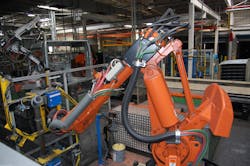Somewhat obscured by the fuss being made over autonomous vehicles (AVs) is that much of modern-day work is being automated at an even more rapid pace.
Robots are not only taking on more manufacturing duties, they are also doing more work in warehouses, even taking on household chores like cleaning the floors.
We all know that many observers expect autonomous technology to help alleviate the truck driver shortage, at least to a degree, but how will it affect other trucking jobs like dispatching? Load planning? Could they be automated as well?
Maybe – but most likely not. What is going to happen is that the nature of such jobs will change, as will the skills required to perform said jobs as well.
John Larkin, managing director and head of transportation capital markets research for Stifel Capital Markets, touched on this issue within his top ten list of trucking trends to watch in 2017.
“The U.S. needs to overhaul its education system, in our view, as automated manufacturing and 3D printing won’t create the traditional manufacturing jobs often promised by politicians,” he emphasized.
“We essentially need to stop suggesting that all citizens receive a college diploma while developing and providing an alternate educational path that equips a sufficient number of young people with the skills necessary to program a computerized machine tool, maintain a robotic welding machine, re-optimize an automated warehouse, operate a platoon of trucks, etc.,” he stressed.
“When will our political leaders wake up and recognize the need for this new wave blue collar educational path?" he said. "Or will automation lead to increased unemployment, a smaller workforce, and all the attendant social problems?”
A new report by Accenture Strategy highlights that concern even further, noting that in what the firm describes as “a rapidly changing digital landscape,” CEOs must lead the charge in "re-skilling" their people to be relevant in the future and ready to adapt to change.
According to Accenture’s report, Harnessing: Revolution: Creating the Future Workforce, CEOs must be mindful to put their people first and at the center of change to create the future workforce.
The stakes are high for businesses, workers and society as a whole as the report argues that development of human skills such as leadership, critical thinking and creative skills, as well as emotional intelligence, would reduce job losses due to total automation considerably.
Accenture’s report, based on a survey of 10,527 working people in ten countries, further shows that if the rate at which workers build relevant skills is doubled, the share of jobs at risk of total automation in the U.S. in 2025 would be reduced from 10% to 4%.
“Paradoxically, the truly human skills, from leadership to creativity, will remain highly relevant and winning organizations will strike the right balance – leveraging the best of technology to elevate, not eliminate their people,” noted Ellyn Shook, chief leadership and human resources officer at Accenture, in this report.
“Not only are workers optimistic, but they understand they must learn new skills,” Shook said. “Digital can accelerate learning by embedding training seamlessly into daily work – so learning becomes a way of life – helping workers and organizations remain relevant.”
Accenture also found that, from the U.S. and France to Brazil, India and six other major countries, people responding to its survey were surprisingly positive about the impact of digital technology on the workplace. Fully 84% of workers polled by the firm said they are "excited" about the impact of digital on their jobs, while more than two-thirds think that technologies such as robots, data analytics and artificial intelligence will help them be more efficient (74%), learn new skills (73%) and improve the quality of their work (66%).
On top of that, 87% of those “working people” as Accenture called them (hmmmm …) expect parts of their job to be automated in the next five years, ranging from 93% of millennials to 79 % of baby boomers. However, of those who expect automation to occur, 80% anticipate more opportunities than challenges in how automation will impact their work experiences in the next five years.
Additional Accenture research, by the by, shows that artificial intelligence alone has the potential to double the annual economic growth rates and boost labor productivity by up to 40% by 2035 in the 12 developed countries examined.
Thus, to help properly “shape” this future workforce, Accenture offered up a few recommendations:
- Accelerate “re-skilling”: From top to bottom, invest in technical and more human skills involving creativity and judgment, taking advantage of the fact that 85% of workers are ready to invest their free time in the next six months to learn new skills. Scale re-skilling by using digital technology. This can include wearable technologies, such as smart glasses that provide technical advice and information as workers carry out tasks. It can also include intelligent software to personalize training that offers recommendations to support an individual’s life-long learning needs.
- Redesign work to unlock human potential: Co-create role-based, gig-like employment opportunities to satisfy workers’ demands for more varied work and flexible arrangements. Develop platforms through which a range of resources and services can be offered to employees and freelancers alike in order to create a compelling community that keeps top talent loyal.
- Strengthen the talent pipeline from its source: Address industry-wide skills shortages by supporting longer term, collective solutions. These include public private partnerships designed to create a broad adoption of skills training. Work with the education sector to design curricula that develop relevant skills at the beginning of the talent supply chain.
At lot of this, of course, must be tweaked to fit the needs of the trucking industry. But it’s worth thinking about now as the automation of work seems poised to accelerate in the very near future.


